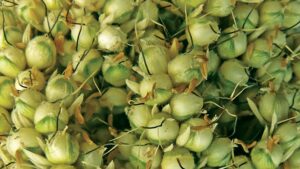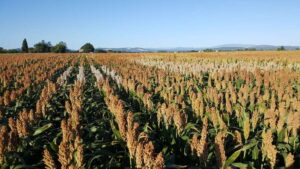Texas storm, temperature and precipitation extremes challenge seed production.
Although Mark Twain was referring to New England with his famous “if you don’t like the weather now, just wait a few minutes” quote, many Texas seed producers may wish it applied to them this year. Extreme temperatures and precipitation have challenged the industry.
“Extreme weather has become more common. There is no extreme anymore,” quips Carson Ward, general manager, GW Seed based in Hereford, Texas. “It brings another set of challenges which continues with drought, flood, high temperatures and who knows what in the end yet.”
The first shake-up in 2021 was Winter Storm Uri, which struck the state in mid-February. Texas A&M AgriLife Extension Service officials estimate the storm caused at least $600 million in agricultural losses across Texas. Freezing temperatures and ice killed or harmed many crops, and residual issues continued to affect company and producer pocketbooks well into the new year.
Extension officials noted 2021’s winter conditions rivaled the historic storm that affected Texas crop production in December 1989. It is still considered the worst winter for crop losses in the region. Other notable freezes in 2004 and 2011 also damaged South Texas crops.
“Many ‘old-timers’ claim they remember times just as cold, but not as cold for as long. The extended sub-freezing temperatures were a ‘once every 50 or more years’ experience for most of the state,” says Bryan Gentsch, executive vice president for Texas Seed Trade Association.
Although the winter was unusually chilly, Gentsch says many seed producers welcomed the moisture that came with it.
“Lots of Texas had three, distinct snowfall events and that is three more than we usually experience, except for the High Plains,” he says.
“There are still many as yet unknown and lingering effects of Winter Storm Uri,” adds Monty Dozier, AgriLife Extension program director for disaster assessment and recovery. “What we can say is these figures are conservative and we expect more losses long-term from this disaster.”
Samuel Zapata, Texas A&M AgriLife Extension economist based in Weslaco, Texas, agrees there is a ripple effect to the economy from winter storm damage.
“Summer drought conditions put even more pressure on parts of Texas production,” he says. “It will be a slow recovery for the industry, although annual crops can bounce back more quickly.”
Corn and grain sorghum planted in South Texas and the state’s Coastal Bend before the storm had to be replanted, Zapata notes, although the most significant grain crop at risk during the storm was wheat, since the majority of it had started to grow. Statewide losses of oats, rye grass and triticale were also included in the total state crop loss estimate.
“Crop production effects were largely limited to winter wheat seed crops. Cold did not seem to have any large-scale detrimental effects on small grain seed production. Small grain seed producers in the West believe wheat seed supply this fall should be adequate,” reports Gentsch.
He queried members following the storm, and none reported any lingering losses related to winter weather. However, some seed businesses had difficulty getting employees to work during the cold and snow while delays, shipping and supply problems were unrelated to the weather.
East Texas Seed in Tyler, Texas, says winter temperatures did not create havoc for their wheat and oat seed production in the eastern part of the state and in Arkansas. However, spring rainfall 10-11 inches above normal fell in late April and May, creating other problems.
“Wheat and oat combines could not get into the fields in a timely manner during the spring and so some seed shortage is possible,” says sales person Andy Young. “It could be a tough fall with possible short crops for some small grains. Flooding in Mississippi and Alabama may affect millet seed production as well, which would limit our ability to sell that seed to customers.”
Young is also concerned about forage and grass seed availability. East Texas Seed markets a full product line of grass and field, wildflower and turf seed. He says it was too wet for field preparation for Bermuda, Bahia and sorghum-sudangrass in the spring. Worsening the potential yield problem was high fertilizer prices that kept growers from applying the normal rates.
“We get legumes and winter grass seed from the Willamette Valley, where summer drought and high temperatures impacted production. Higher prices were already being quoted,” he says.
“The winter storm was a big event with an entire-state impact. But winter storms are less frequent and relatively less damaging than regional hurricanes … You have to factor in the weather.” Samuel Zapata
Drought was a major concern in western Texas during the summer, according to Gentsch.
“We normally do not expect much rainfall after June 1 but received well under our normal for the spring and headed into the normally hot, dry periods with less soil moisture than usual. Hybrid sorghum and peanuts may be the two largest seed crops affected by drought followed by cotton,” he explains.
About 85% of the global supply of hybrid sorghum seed is produced on the Texas High Plains and there are limits as to how much irrigation water can be used. Advanta Seed is one of the companies producing sorghum seed in the state. Advanta’s seed research is based in Hereford and seed production is primarily around Dumas and the northern panhandle.
Zach Eder, technology development manager based in El Campo, Texas, agrees weather during the last year has been a test. “I go back to November/December 2020 when a large market had developed for sorghum and we saw a big flux of acreage into sorghum. We had adequate seed supply then and geared up for larger production in 2021 to accommodate the increased demand.”
Eder says sorghum seed planted in January came under attack during the February cold spell. Replanting ate into existing seed supplies. A mild spring delayed crop growth, which delayed anticipated harvest dates. Nearly daily rains in May and June also delayed harvest for farmers.
Prospects for sorghum seed production are more promising since that seed was planted later than crops planted by farmers. “Good rainfall and humidity for evapotranspiration in the summer should make a good seed crop,” he says. “The last three or four years we had early freezes. We need to make it to October 10 without a freeze to preserve seed quality with strong supplies.”
Eder’s confidence also comes with research that has strengthened seed production capabilities.
“Finding herbicide-tolerant and sugarcane-aphid tolerant parents has been an opportunity to really step up the seed production system,” he says. “We are able to use these weed- and pest-tolerant sorghum hybrids to make seed production even more stable and reliable. We are excited with the prospects, despite the weather, and see a bright future for sorghum growth.”
And while no crystal ball can predict the forecast for the remainder of 2021, the National Weather Service extended forecast into September predicted the western half of Texas could have above-normal temperatures with near-normal precipitation while the rest of the state may experience near-normal temperatures and a greater chance of above-normal precipitation.
“The winter storm was a big event with an entire-state impact,” says Zapata. “But winter storms are less frequent and relatively less damaging than regional hurricanes. Hurricane Hanna in 2020 left South Texas with almost $400 million in damage to commodities, including corn, cotton lint, cottonseed, sorghum, citrus, sugarcane, sesame and soybean. You have to factor in the weather.”













